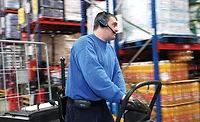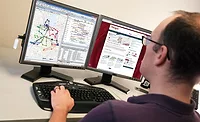Distribution
Evolution of telematics technology helps distributors realize benefits
ELD mandate furthers telematics adoption among beverage operations

In the “Arthur” episode titled “Muffy and the Big, Bad Blog,” Muffy Crosswire invites her classmates to visit her new blog that will detail her upcoming trip to Costa Rica. Mr. Ratburn, her teacher, states that he will swing by and asks if he can bring anything. The class then explains to him that the blog is a digital landing page where people share their thoughts. Mr. Ratburn expresses his fascination to look into it, writing down the information in a notebook.
Although today’s truck drivers are not as a technologically challenged as Mr. Ratburn, many were fast tracked to a more digital world when the electronic logging device (ELD) mandate took effect at the end of 2019. To comply with the congressionally mandated technology, beverage operations are turning to telematics as a solution, and quickly have learned all the benefits that come with it.
“When the ELD mandate was instituted, we saw a wave of distribution companies rushing to implement telematics,” says Dave Riordan, chief client officer for San Diego-based Lytx. “These organizations quickly realized that the increased visibility that telematics offered represented an important opportunity to improve their safety standards and safeguard against future false claims. Since [then], many have embraced and expanded their use of the technology, currently experiencing the benefits of improved safety, productivity and efficiency.”
Dave Palle, senior director of product management at Dallas-based Omnitracs, notes that beverage distributors have been its strongest adopters to the technology as they want to ensure compliance but also are seeing return-on-investment (ROI) benefits beyond that.
“ELD devices are designed to ensure driver safety, and compliance with all current and past regulations, including Hours of Service (HOS) requirements,” he says. “An ELD is used to electronically record a driver’s Record of Duty Status (RODS), ensuring that drivers no longer have to use unreliable paper logs to record compliance. There’s a cost saving aspect to eliminating paper logs as well.
“Based on assumptions stated by the FMCSA, fleets save $705 per driver per year in paperwork reduction alone,” Palle continues. “E-Logs also help inspire a widespread culture of safety, allowing safety managers and dispatchers to easily work together on routes that are within HOS requirements. The technology also alerts drivers when low drive or on-duty time is near.”
Lytx’s Riordan explains that telematics also can identify violations and issues before they impact a CSA score, thereby helping to reduce overall violations through these automatic audits.
“Our solution integrates with more than 20 different industry-leading ELD providers and aggregates data to help safety managers easily identify risks and trends by drivers and locations across their fleet,” he says. “Through this offering, we provide compliance services to more than half of the Top 100 for-hire carriers in the U.S., with 10 million logs audited every month.”
Adjusting to demands
Logistics solutions like telematics also have seen a brighter spotlight as beverage distributors adjust to the stockpiling behavior that consumers exhibited as the coronavirus pandemic proliferated. However, those recent supply chain demands were in addition to the growth that distributors already were feeling.
“Beverage demand, especially for alcohol, continues to grow year in and year out, and is continuing to increase during the COVID-19 crisis,” Omnitracs’ Palle says. “This uptick in demand combined with steep customer expectations has prompted supply chain leaders to rely more heavily on logistics technologies to cut costs and eliminate inefficiencies.
“The enhanced tracking capabilities available with telematics, especially when combined with route plans, for actual versus plan execution management, also offer much-needed transparency that distribution fleets are looking for,” he continues. “Increasingly we’re also seeing on-premise and off-premise delivery recipients desiring alerts regarding the status of their deliveries, and the ability to track their deliveries in realtime on a live map, for full visibility into truck location and the content of their order. In these use cases, telematics systems help provide the real-time locations and projected ETAs.”
Citing an article from Quartz.com, Palle explains that distributors that serve retailers and eCommerce networks have seen some of the biggest demands. These shifts in purchasing patterns are complicating the delivery network and placing more reliance on telematics.
“Sixty-seven percent of food and drink bought by U.S. consumers was purchased at stores in March, the highest share since 1996,” he says. “CPG companies are seeing sales grow too, as consumers have been stockpiling essential products. However, with more eCommerce comes increased order fragmentation, which has an impact on distribution costs for companies handling home delivery. With deliveries spaced over more days and timeframes that often require drivers to retrace routes and travel to the same areas, the demand for high-quality routing, dispatching, alerting and telematics data will continue to increase.”
Visualizing the next steps
Although the ELD mandate accelerated adoption of telematics, the technology is not novel. Because of its longevity, advancements in telematics have taken the technology to new heights.
“The technology is well established and at this point, is considered more of a business necessity than an up-and-coming technology,” Lytx’s Riordan says. “Because of this, more and more fleets are realizing — and experiencing — the value that video telematics, in particular, can provide to their fleet. In addition to helping improve safety and providing greater visibility into fleet performance, video telematics solutions are increasingly able to help fleets improve efficiencies, productivity and customer service as well.”
Riordan details how video telematics can document unsafe behaviors with a goal of eliminating them and providing analytics around them.
“In Lytx’s base offering, dashboard-mounted event recorders collect video around unsafe driving events like a collision, hard brake or distracted driving behaviors, like cell phone use,” he says. “This footage can be used to address complaints or claims against a driver, both unfortunate, but common issues with the branded vehicles many beverage fleets operate. In many cases, this footage can be used to exonerate a driver and save the company money. Our machine vision and AI-powered Lytx Driver Safety Program goes a step further, combining this raw video footage with advanced analytics to pinpoint risky driving habits and provide a workflow for managers to coach drivers toward safer habits.”
Suppliers also tease to even more advancements for the telematics market.
“Open-source cloud platforms can drive innovation at a faster pace, since they enable true collaboration between logistics players,” Palle says. “Omnitracs, for example, just launched Omnitracs One, a cloud-driven, open source technology platform. Partnering with other technology leaders like Red Hat, Omnitracs launched this open API platform with the intention of driving consistent and valuable innovations for the industry. A holistic, flexible solution that offers multiple products in one place, Omnitracs One collects many more data points than traditional telematics systems.”
Looking for a reprint of this article?
From high-res PDFs to custom plaques, order your copy today!





